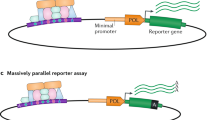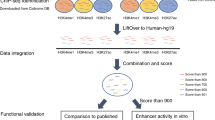Abstract
Development and function of the human heart depend on the dynamic control of tissue-specific gene expression by distant-acting transcriptional enhancers. To generate an accurate genome-wide map of human heart enhancers, we used an epigenomic enhancer discovery approach and identified ∼6,200 candidate enhancer sequences directly from fetal and adult human heart tissue. Consistent with their predicted function, these elements were markedly enriched near genes implicated in heart development, function and disease. To further validate their in vivo enhancer activity, we tested 65 of these human sequences in a transgenic mouse enhancer assay and observed that 43 (66%) drove reproducible reporter gene expression in the heart. These results support the discovery of a genome-wide set of noncoding sequences highly enriched in human heart enhancers that is likely to facilitate downstream studies of the role of enhancers in development and pathological conditions of the heart.
This is a preview of subscription content, access via your institution
Access options
Subscribe to this journal
Receive 12 print issues and online access
$209.00 per year
only $17.42 per issue
Buy this article
- Purchase on Springer Link
- Instant access to full article PDF
Prices may be subject to local taxes which are calculated during checkout




Similar content being viewed by others
References
Hoffman, J.I., Kaplan, S. & Liberthson, R.R. Prevalence of congenital heart disease. Am. Heart J. 147, 425–439 (2004).
Lloyd-Jones, D. et al. Heart disease and stroke statistics—2010 update: a report from the American Heart Association. Circulation 121, e46–e215 (2010).
Bentham, J. & Bhattacharya, S. Genetic mechanisms controlling cardiovascular development. Ann. NY Acad. Sci. 1123, 10–19 (2008).
Bruneau, B.G. The developmental genetics of congenital heart disease. Nature 451, 943–948 (2008).
Pierpont, M.E. et al. Genetic basis for congenital heart defects: current knowledge: a scientific statement from the American Heart Association Congenital Cardiac Defects Committee, Council on Cardiovascular Disease in the Young: endorsed by the American Academy of Pediatrics. Circulation 115, 3015–3038 (2007).
Helgadottir, A. et al. A common variant on chromosome 9p21 affects the risk of myocardial infarction. Science 316, 1491–1493 (2007).
McPherson, R. et al. A common allele on chromosome 9 associated with coronary heart disease. Science 316, 1488–1491 (2007).
Schunkert, H. et al. Large-scale association analysis identifies 13 new susceptibility loci for coronary artery disease. Nat. Genet. 43, 333–338 (2011).
Visel, A., Rubin, E.M. & Pennacchio, L.A. Genomic views of distant-acting enhancers. Nature 461, 199–205 (2009).
Visel, A. et al. Targeted deletion of the 9p21 non-coding coronary artery disease risk interval in mice. Nature 464, 409–412 (2010).
Chen, X. et al. Integration of external signaling pathways with the core transcriptional network in embryonic stem cells. Cell 133, 1106–1117 (2008).
Heintzman, N.D. et al. Distinct and predictive chromatin signatures of transcriptional promoters and enhancers in the human genome. Nat. Genet. 39, 311–318 (2007).
Visel, A. et al. ChIP-seq accurately predicts tissue-specific activity of enhancers. Nature 457, 854–858 (2009).
Xi, H. et al. Identification and characterization of cell type–specific and ubiquitous chromatin regulatory structures in the human genome. PLoS Genet. 3, e136 (2007).
Blow, M.J. et al. ChIP-Seq identification of weakly conserved heart enhancers. Nat. Genet. 42, 806–810 (2010).
Arany, Z., Sellers, W.R., Livingston, D.M. & Eckner, R. E1A-associated p300 and CREB-associated CBP belong to a conserved family of coactivators. Cell 77, 799–800 (1994).
Eckner, R. et al. Molecular cloning and functional analysis of the adenovirus E1A-associated 300-kD protein (p300) reveals a protein with properties of a transcriptional adaptor. Genes Dev. 8, 869–884 (1994).
Ogryzko, V.V., Schiltz, R.L., Russanova, V., Howard, B.H. & Nakatani, Y. The transcriptional coactivators p300 and CBP are histone acetyltransferases. Cell 87, 953–959 (1996).
Capaldi, A.P. et al. Structure and function of a transcriptional network activated by the MAPK Hog1. Nat. Genet. 40, 1300–1306 (2008).
McLean, C.Y. et al. GREAT improves functional interpretation of cis-regulatory regions. Nat. Biotechnol. 28, 495–501 (2010).
Ashburner, M. et al. Gene ontology: tool for the unification of biology. The Gene Ontology Consortium. Nat. Genet. 25, 25–29 (2000).
Dimas, A.S. et al. Common regulatory variation impacts gene expression in a cell type–dependent manner. Science 325, 1246–1250 (2009).
Siepel, A. et al. Evolutionarily conserved elements in vertebrate, insect, worm, and yeast genomes. Genome Res. 15, 1034–1050 (2005).
Narlikar, L. et al. Genome-wide discovery of human heart enhancers. Genome Res. 20, 381–392 (2010).
Henderson, D.J. & Anderson, R.H. The development and structure of the ventricles in the human heart. Pediatr. Cardiol. 30, 588–596 (2009).
Coppen, S.R. et al. Comparison of connexin expression patterns in the developing mouse heart and human foetal heart. Mol. Cell. Biochem. 242, 121–127 (2003).
Kothary, R. et al. A transgene containing lacZ inserted into the dystonia locus is expressed in neural tube. Nature 335, 435–437 (1988).
Pennacchio, L.A. et al. In vivo enhancer analysis of human conserved non-coding sequences. Nature 444, 499–502 (2006).
Blake, J.A., Bult, C.J., Eppig, J.T., Kadin, J.A. & Richardson, J.E. The Mouse Genome Database genotypes:phenotypes. Nucleic Acids Res. 37, D712–D719 (2009).
Morimoto, T., Sunagawa, Y., Fujita, M. & Hasegawa, K. Novel heart failure therapy targeting transcriptional pathway in cardiomyocytes by a natural compound, curcumin. Circ. J. 74, 1059–1066 (2010).
Thompson, P.R. et al. Regulation of the p300 HAT domain via a novel activation loop. Nat. Struct. Mol. Biol. 11, 308–315 (2004).
Li, H. & Durbin, R. Fast and accurate short read alignment with Burrows-Wheeler transform. Bioinformatics 25, 1754–1760 (2009).
Kuhn, R.M. et al. The UCSC Genome Browser Database: update 2009. Nucleic Acids Res. 37, D755–D761 (2009).
Birney, E. et al. Identification and analysis of functional elements in 1% of the human genome by the ENCODE pilot project. Nature 447, 799–816 (2007).
Ernst, J. et al. Mapping and analysis of chromatin state dynamics in nine human cell types. Nature 473, 43–49 (2011).
Conti, A. et al. Altered expression of mitochondrial and extracellular matrix genes in the heart of human fetuses with chromosome 21 trisomy. BMC Genomics 8, 268 (2007).
Blankenberg, D. et al. Galaxy: a web-based genome analysis tool for experimentalists. Curr. Protoc. Mol. Biol. Chapter 19, Unit 19.10.1–19.10.21 (Wiley, 2010).
Goecks, J., Nekrutenko, A. & Taylor, J. Galaxy: a comprehensive approach for supporting accessible, reproducible, and transparent computational research in the life sciences. Genome Biol. 11, R86 (2010).
Sherry, S.T. et al. dbSNP: the NCBI database of genetic variation. Nucleic Acids Res. 29, 308–311 (2001).
Hinrichs, A.S. et al. The UCSC Genome Browser Database: update 2006. Nucleic Acids Res. 34, D590–D598 (2006).
Nobrega, M.A., Ovcharenko, I., Afzal, V. & Rubin, E.M. Scanning human gene deserts for long-range enhancers. Science 302, 413 (2003).
Visel, A., Minovitsky, S., Dubchak, I. & Pennacchio, L.A. VISTA Enhancer Browser—a database of tissue-specific human enhancers. Nucleic Acids Res. 35, D88–D92 (2007).
Acknowledgements
The authors thank R. Hosseini and S. Phouanenavong for technical support, S. Deutsch for help in retrieving human genetic data and C. Attanasio and D. Dickel for critical comments on the manuscript. L.A.P. and A.V. were supported by a grant funded by the National Human Genome Research Institute (HG003988). B.L.B. was supported by grants from the National Heart, Lung, and Blood Institute (NHLBI, HL64658 and HL89707). D.M. and T.K. were supported by European Molecular Biology Organization (EMBO) long-term postdoctoral fellowships. B.C.J. was supported by the GlaxoSmithKline Research and Education Foundation for Cardiovascular Disease, University of California, San Francisco (UCSF) Foundation for Cardiac Research and a grant from the NHLBI (HL096836). P.C.S. was supported by the NHLBI and the Department of Veterans Affairs. Research was performed at Lawrence Berkeley National Laboratory and at the United States Department of Energy Joint Genome Institute (Department of Energy Contract DE-AC02-05CH11231, University of California).
Author information
Authors and Affiliations
Contributions
D.M., E.M.R., J.B., L.A.P. and A.V. conceived of and designed the experiments. D.M., M.J.B., T.K., D.J.M., B.C.J., J.A.A., A.H., I.P.-F., M.S., C.W. and V.A. performed experiments and data analysis. P.C.S. and B.L.B. provided reagents and materials and performed data analysis. All authors contributed to the writing of the manuscript.
Corresponding authors
Ethics declarations
Competing interests
The authors declare no competing financial interests.
Supplementary information
Supplementary Text and Figures
Supplementary Note, Supplementary Figures 1–12 and Supplementary Tables 1–12. (PDF 5528 kb)
Rights and permissions
About this article
Cite this article
May, D., Blow, M., Kaplan, T. et al. Large-scale discovery of enhancers from human heart tissue. Nat Genet 44, 89–93 (2012). https://doi.org/10.1038/ng.1006
Received:
Accepted:
Published:
Issue Date:
DOI: https://doi.org/10.1038/ng.1006
This article is cited by
-
Neuronal transcription of autism gene PTCHD1 is regulated by a conserved downstream enhancer sequence
Scientific Reports (2023)
-
iEnhancer-DCLA: using the original sequence to identify enhancers and their strength based on a deep learning framework
BMC Bioinformatics (2022)
-
Genomic enhancers in cardiac development and disease
Nature Reviews Cardiology (2022)
-
Transcriptional enhancers and their communication with gene promoters
Cellular and Molecular Life Sciences (2021)
-
Enhancer RNAs are an important regulatory layer of the epigenome
Nature Structural & Molecular Biology (2020)



